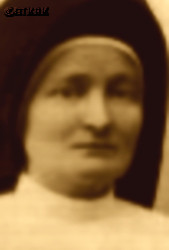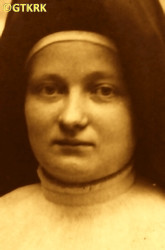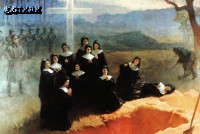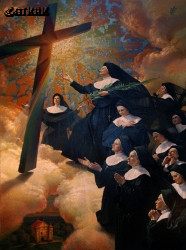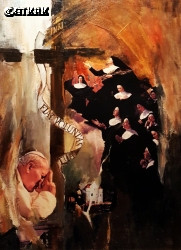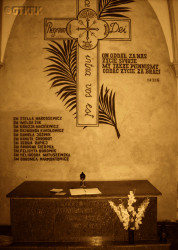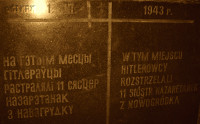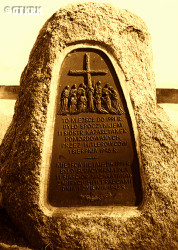Roman Catholic
St Sigismund parish
05-507 Słomczyn
85 Wiślana Str.
Konstancin deanery
Warsaw archdiocese, Poland
full list:
displayClick to display full list

searchClick to search full list by categories
wyświetlKliknij by wyświetlić pełną listę po polsku

szukajKliknij by przeszukać listę wg kategorii po polsku

Martyrology of the clergy — Poland
XX century (1914 – 1989)
personal data
religious status
blessed
surname
ŻAK
forename(s)
Hedwig Caroline (pl. Jadwiga Karolina)
religious forename(s)
Mary Imelda of Host Jesus (pl. Maria Imelda od Jezusa Hostii)
function
nun
creed
Latin (Roman Catholic) Church RCmore on
en.wikipedia.org
[access: 2014.09.21]
congregation
Congregation of the Sisters of the Holy Family of Nazareth CSFNmore on
en.wikipedia.org
[access: 2013.05.19]
(i.e. Sisters of the Holy Family of Nazareth)
diocese / province
Warsaw Province of Holiest Name of Jesus CSFN
date and place
of death
01.08.1943

Batorówkaforester's lodge
today: non‐existent, Koshelevo ssov., Navahrudak dist., Grodno reg., Belarus
more on
www.radzima.net
[access: 2020.07.31]
details of death
After German and Russian invasion of Poland in 09.1939 and start of the World War II, after start of Russian occupation persecuted with co‐nuns by the Russians — forbidden to conduct school duties, forced to leave their Congregation's house and to take up various jobs in Navahrudak.
She was the only one to still wear her cassock — the rest had to take theirs off.
The nuns scattered and found refuge in private houses.
Worked as cleaners and servants.
But met together and sent parcels to Poles deported by the Russians to Siberia.
After the German attack on 22.06.1941 of the former ally, the Russians, and the beginning of German occupation nuns returned to their Congregation's house, put on their cassocks and started working with children and youth.
After arrest on 17‐18.07.1943 in Navahrudak — as part of anti–partisan drive Operation „Hermann” — of about 120 people as hostages by the Germans, together with her 10 co‐nuns offered their lives in exchange for life of families and children and the priest — Navahrudak dean and parish priest, chaplain to the nuns, Fr Alexander Zienkiewicz.
And Germans commuted death sentences of most of the hostages to deportation for slave labour in Germany.
On 24.07.1943 they were transported out of Navahrudak — a few were released.
All survived the World War II.
And on 31.07.1943 Germans summoned the nuns to the police station in Navahrudak.
When at c. 19.30 complied immediately got arrested and driven out.
Not being able though to find the right place for execution brought back and locked in local jail cell.
At dawn once again driven out on a truck and about 5 km from the city, in the forest, murdered — still in their cassocks, not tied up or bound.
cause of death
mass murder
perpetrators
Germans
sites and events
Operation „Hermann”Click to display the description, Collective responsibility („Hostages”)Click to display the description, Ribbentrop‐MolotovClick to display the description, Pius XI's encyclicalsClick to display the description
date and place
of birth
29.12.1892

Oświęcimtoday: Oświęcim gm., Oświęcim pov., Lesser Poland voiv., Poland
more on
en.wikipedia.org
[access: 2021.06.07]
parents
ŻAK Joseph
🞲 ?, ? — 🕆 ?, ?

ZIORA Sophia
🞲 ?, ? — 🕆 ?, ?
baptism
01.1893

Oświęcimtoday: Oświęcim gm., Oświęcim pov., Lesser Poland voiv., Poland
more on
en.wikipedia.org
[access: 2021.06.07]
Assumption of the Blessed Virgin Mary RC church
religious vows
15.08.1913 (temporary)
23.01.1921 (permanent)
positions held
1936 – 1943
nun — Navahrudaktoday: Navahrudak dist., Grodno reg., Belarus
more on
en.wikipedia.org
[access: 2021.07.04] ⋄ Christ the King Congregation's house, Sisters of the Holy Family of Nazareth CSFN — teacher in a school run by the Congregation, sacristan and caretaker of altar boys in the parish church of Transfiguration, served in „White Parish Church” and the house of the community of Christ the King
till c. 1936
nun — Łukówtoday: Łuków urban gm., Łuków pov., Lublin voiv., Poland
more on
en.wikipedia.org
[access: 2020.09.24] ⋄ Congregation's house, Sisters of the Holy Family of Nazareth CSFN — tutor of the boys in the orphanage and sacristan at the church
nun — Grodnotoday: Grodno dist., Grodno reg., Belarus
more on
en.wikipedia.org
[access: 2023.01.18] ⋄ Congregation's house, Sisters of the Holy Family of Nazareth CSFN — teacher of school run by the Congregation and a boarding school tutor
from c. 1930
nun — Stryitoday: Stryi urban hrom., Stryi rai., Lviv obl., Ukraine
more on
en.wikipedia.org
[access: 2020.12.03] ⋄ Congregation's house, Sisters of the Holy Family of Nazareth CSFN — teacher of school run by the Congregation and a boarding school tutor
1922 – 1930
nun — Warsawtoday: Warsaw city pov., Masovia voiv., Poland
more on
en.wikipedia.org
[access: 2021.10.09] ⋄ Congregation's house, Sisters of the Holy Family of Nazareth CSFN — service at the Primary School run by the Congregation at Litewska Str., incl. geography teacher; also: boarding school tutor
c. 1922
nun — Lvivtoday: Lviv urban hrom., Lviv rai., Lviv obl., Ukraine
more on
en.wikipedia.org
[access: 2022.01.16] ⋄ Congregation's house, Sisters of the Holy Family of Nazareth CSFN — completion of education at the gymnasium level, crowned with an extramural maturity exam (matura) at the State Teachers' Seminary in Sambir
1920 – 1922
nun — Rometoday: Rome prov., Lazio reg., Italy
more on
en.wikipedia.org
[access: 2021.12.18] ⋄ General House (at 18 Via Machiavelli), Sisters of the Holy Family of Nazareth CSFN
1913 – 1919
nun — Lvivtoday: Lviv urban hrom., Lviv rai., Lviv obl., Ukraine
more on
en.wikipedia.org
[access: 2022.01.16] ⋄ Congregation's house, Sisters of the Holy Family of Nazareth CSFN — ministry in a school run by the Congregation; also: supplementing education at the gymnasium level, e.g. at the Women's Teachers' Seminary, where in 1914 she obtained the patent of the „master of the Froebel garden” (i.e. a kindergarten tutoress in accordance with the educational principles developed by Friedrich Fröbel, a German pedagogue and theoretician)
till 15.08.1913
novitiate — Albano Lazialetoday: Rome prov., Lazio reg., Italy
more on
en.wikipedia.org
[access: 2022.04.17] ⋄ Congregation's house, Sisters of the Holy Family of Nazareth CSFN
c. 1911
postulate — Viennatoday: Vienna state, Austria
more on
en.wikipedia.org
[access: 2020.07.31] ⋄ Blessed Virgin Mary Help of Christians Congregation's house, Sisters of the Holy Family of Nazareth CSFN — care for children of Polish immigrants
c. 1911
postulate — Wadowicetoday: Wadowice gm., Wadowice pov., Lesser Poland voiv., Poland
more on
en.wikipedia.org
[access: 2021.12.18] ⋄ Congregation's house, Sisters of the Holy Family of Nazareth CSFN — ministry at the local hospital
13.05.1911
accession — Krakówtoday: Kraków city pov., Lesser Poland voiv., Poland
more on
en.wikipedia.org
[access: 2021.06.07] ⋄ Sisters of the Holy Family of Nazareth CSFN
others related
in death
BOROWIKClick to display biography Pauline (Sr Mary Felicity), CHROBOTClick to display biography Josefa (Sr Mary Canute of Jesus in Gethsemane), CIERPKAClick to display biography Helen (Sr Mary Gwidona of Divine Mercy), JÓŹWIKClick to display biography Eleonor Angela (Sr Mary Daniella of Jesus and Virgin Mary), KOKOŁOWICZClick to display biography Anne (Sr Mary Raymonda of Jesus and Mary), MACKIEWICZClick to display biography Eugenia (Sr Mary Canisia), MARDOSEWICZClick to display biography Adele (Sr Mary Stella of the Blessed Sacrament), MATUSZEWSKAClick to display biography Leocadia (Sr Mary Heliodora), NARMONTOWICZClick to display biography Veronica (Sr Mary Boromea), RAPIEJClick to display biography Julia (Sr Mary Sergia of Our Lady of Sorrows)
sites and events
descriptions
Operation „Hermann”: On 19.06.1943 a unit of Polish resistance Home Army AK (part of Polish Clandestine State) from Stowbtsy in Belarus attacked Ivyanets. The town was captured — in history this act is known as „Ivyanets insurgency” — and German garrison defeated. All prisoners were released, among them a dozen or so Jews, including a few physicians. C. 40‐150 Germans and their collaborators were executed. C. 100‐200 functionaries of Belarusian support police, collaborating with Germans, voluntarily joined the partisan unit. After 18 hours partisans left Ivyanets and moved towards nearby Nalibocka Forest. In retaliation Germans immediately murdered c. 150 inhabitants of Ivyanets and organized a wide ranging anti‐partisan operation known under its codename „Hermann”. The main aim was elimination of partisan units — Polish and Russian — operating in Nalibocka Forest. It started on 13.07.1943. C. 9,000 Germans and its collaborators — including Russians — participated supported by airplanes, artillery and heavy weaponry. Around the forest Germans set up a strip of „scorched earth”, c. 10‐15 km wide. During operation Germans burnt to ground more than 60 Polish and Belarus villages and murdered c. 4,280 civilians including a few Catholic priests — those regarded as supporting the partisans were executed, hanged, burnt alive. C. 21,000‐25,000 civilians were sent to 3rd Reich, i.e. Germany, for slave labour, and thousands — including elderly, women and children — were evicted beyond the blockade strip. Partisans however — both Polish and Russians — managed to break of the encirclement, despite huge losses. One of the towns in the vicinity of the region under operation — c. 20 km from Nalibocka Forest — was Nowogródek. During the operation Germans arrested there c. 120 its inhabitants and regarded as hostages. Local Sisters of the Holy Family of Nazareth nuns — in Nowogródek since 04.09.1929, providing religious education and instruction to children and youth — stood up in their defense. 11 of them were arrested by the Germans and murdered. (more on: en.wikipedia.orgClick to attempt to display webpage
[access: 2018.10.04])
Collective responsibility („Hostages”): A criminal practice implemented by the Germans in the occupied territories of Poland, applied from the very first day of World War II. At its core was an appointment and public announcement of a list of names of selected people whose lives depended on absolute compliance with German orders. Any violation of these ordinances, by any person, regardless of the circumstances, resulted in the murder of the designated „hostages”. In the first days of the war and occupation, it was used i.a. by the German Wehrmacht army to prevent acts of continuation of the defense by the Poles. Later, especially in the German‐run General Governorate, it was part of the official policy of the occupation authorities — collective responsibility for any acts of resistance to the occupier's practices. For the life of one German, even if death was due to customary reasons, the Germans carried out executions from a dozen to even a hundred Poles previously designated as „hostages”.
Ribbentrop‐Molotov: Genocidal Russian‐German alliance pact between Russian leader Joseph Stalin and German leader Adolf Hitler signed on 23.08.1939 in Moscow by respective foreign ministers, Mr. Vyacheslav Molotov for Russia and Joachim von Ribbentrop for Germany. The pact sanctioned and was the direct cause of joint Russian and German invasion of Poland and the outbreak of the World War II in 09.1939. In a political sense, the pact was an attempt to restore the status quo ante before 1914, with one exception, namely the „commercial” exchange of the so‐called „Kingdom of Poland”, which in 1914 was part of the Russian Empire, fore Eastern Galicia (today's western Ukraine), in 1914 belonging to the Austro‐Hungarian Empire. Galicia, including Lviv, was to be taken over by the Russians, the „Kingdom of Poland” — under the name of the General Governorate — Germany. The resultant „war was one of the greatest calamities and dramas of humanity in history, for two atheistic and anti‐Christian ideologies — national and international socialism — rejected God and His fifth Decalogue commandment: Thou shall not kill!” (Abp Stanislav Gądecki, 01.09.2019). The decisions taken — backed up by the betrayal of the formal allies of Poland, France and Germany, which on 12.09.1939, at a joint conference in Abbeville, decided not to provide aid to attacked Poland and not to take military action against Germany (a clear breach of treaty obligations with Poland) — were on 28.09.1939 slightly altered and made more precise when a treaty on „German‐Russian boundaries and friendship” was agreed by the same murderous signatories. One of its findings was establishment of spheres of influence in Central and Eastern Europe and in consequence IV partition of Poland. In one of its secret annexes agreed, that: „the Signatories will not tolerate on its respective territories any Polish propaganda that affects the territory of the other Side. On their respective territories they will suppress all such propaganda and inform each other of the measures taken to accomplish it”. The agreements resulted in a series of meeting between two genocidal organization representing both sides — German Gestapo and Russian NKVD when coordination of efforts to exterminate Polish intelligentsia and Polish leading classes (in Germany called «Intelligenzaktion», in Russia took the form of Katyń massacres) where discussed. Resulted in deaths of hundreds of thousands of Polish intelligentsia, including thousands of priests presented here, and tens of millions of ordinary people,. The results of this Russian‐German pact lasted till 1989 and are still in evidence even today. (more on: en.wikipedia.orgClick to attempt to display webpage
[access: 2015.09.30])
Pius XI's encyclicals: Facing the creation of two totalitarian systems in Europe, which seemed to compete with each other, though there were more similarities than contradictions between them, Pope Pius XI issued in 03.1937 (within 5 days) two encyclicals. In the „Mit brennender Sorge” (Eng. „With Burning Concern”) published on 14.03.1938, condemned the national socialism prevailing in Germany. The Pope wrote: „Whoever, following the old Germanic‐pre‐Christian beliefs, puts various impersonal fate in the place of a personal God, denies the wisdom of God and Providence […], whoever exalts earthly values: race or nation, or state, or state system, representatives of state power or other fundamental values of human society, […] and makes them the highest standard of all values, including religious ones, and idolizes them, this one […] is far from true faith in God and from a worldview corresponding to such faith”. On 19.03.1937, published „Divini Redemptoris” (Eng. „Divine Redeemer”), in which criticized Russian communism, dialectical materialism and the class struggle theory. The Pope wrote: „Communism deprives man of freedom, and therefore the spiritual basis of all life norms. It deprives the human person of all his dignity and any moral support with which he could resist the onslaught of blind passions […] This is the new gospel that Bolshevik and godless communism preaches as a message of salvation and redemption of humanity”… Pius XI demanded that the established human law be subjected to the natural law of God , recommended the implementation of the ideal of a Christian state and society, and called on Catholics to resist. Two years later, National Socialist Germany and Communist Russia came together and started World War II. (more on: www.vatican.vaClick to attempt to display webpage
[access: 2023.05.28], www.vatican.vaClick to attempt to display webpage
[access: 2023.05.28])
sources
personal:
pl.wikipedia.orgClick to attempt to display webpage
[access: 2012.11.23], opoka.org.plClick to attempt to display webpage
[access: 2018.10.04]
bibliographical:
„A martyrology of Polish clergy under German occupation, 1939‐1945”, Fr Szołdrski Vladislaus CSSR, Rome 1965
original images:
commons.wikimedia.orgClick to attempt to display webpage
[access: 2021.12.19], www.facebook.comClick to attempt to display webpage
[access: 2022.12.16], www.radiomaryja.plClick to attempt to display webpage
[access: 2018.10.04], kosciol.wiara.plClick to attempt to display webpage
[access: 2018.10.04], swstefan.plClick to attempt to display webpage
[access: 2018.10.04], get.google.comClick to attempt to display webpage
[access: 2018.10.04], www.flickr.comClick to attempt to display webpage
[access: 2014.05.09], www.flickr.comClick to attempt to display webpage
[access: 2014.05.09], blogmedia24.plClick to attempt to display webpage
[access: 2014.05.09], blogmedia24.plClick to attempt to display webpage
[access: 2014.05.09]
LETTER to CUSTODIAN/ADMINISTRATOR
If you have an Email client on your communicator/computer — such as Mozilla Thunderbird, Windows Mail or Microsoft Outlook, described at WikipediaPatrz:
en.wikipedia.org, among others — try the link below, please:
LETTER to CUSTODIAN/ADMINISTRATORClick and try to call your own Email client
If however you do not run such a client or the above link is not active please send an email to the Custodian/Administrator using your account — in your customary email/correspondence engine — at the following address:

giving the following as the subject:
MARTYROLOGY: ŻAK Hedwig Caroline
To return to the biography press below:
 Click to return to biography
Click to return to biography








